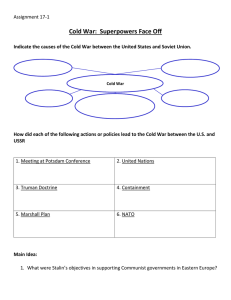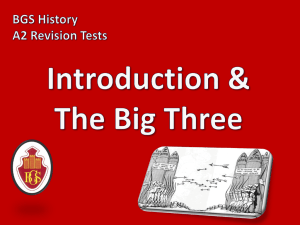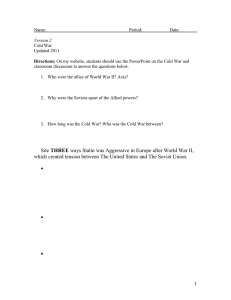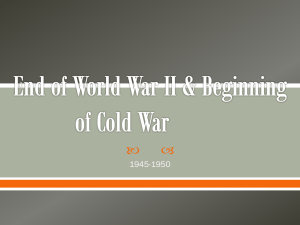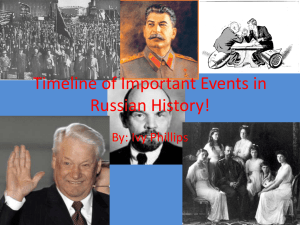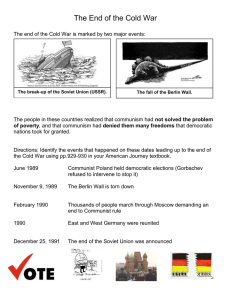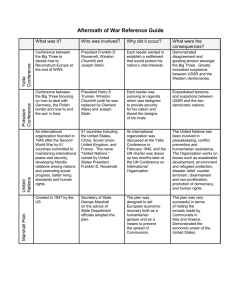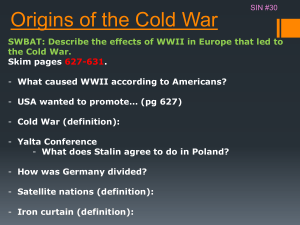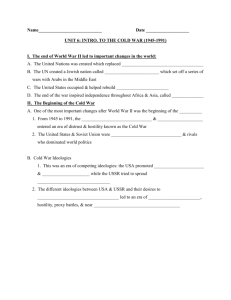The Cold War
advertisement
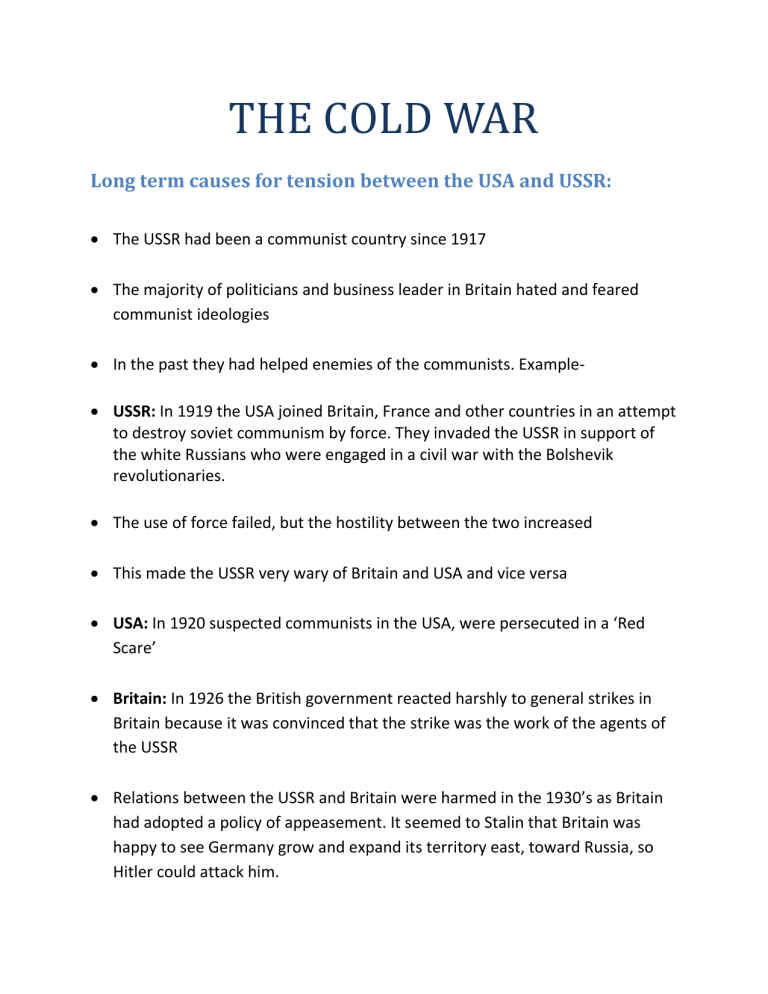
THE COLD WAR Long term causes for tension between the USA and USSR: The USSR had been a communist country since 1917 The majority of politicians and business leader in Britain hated and feared communist ideologies In the past they had helped enemies of the communists. Example USSR: In 1919 the USA joined Britain, France and other countries in an attempt to destroy soviet communism by force. They invaded the USSR in support of the white Russians who were engaged in a civil war with the Bolshevik revolutionaries. The use of force failed, but the hostility between the two increased This made the USSR very wary of Britain and USA and vice versa USA: In 1920 suspected communists in the USA, were persecuted in a ‘Red Scare’ Britain: In 1926 the British government reacted harshly to general strikes in Britain because it was convinced that the strike was the work of the agents of the USSR Relations between the USSR and Britain were harmed in the 1930’s as Britain had adopted a policy of appeasement. It seemed to Stalin that Britain was happy to see Germany grow and expand its territory east, toward Russia, so Hitler could attack him. Stalin responded to this threat by signing the Molotov-Ribbentrop pact, which stunned Britain and the USA. A difference in ideology: Capitalist Communist The USA was capitalist- Business The USSR was communist, the and property were privately owned industry was run by the state It was a democracy- the government was chosen in free democratic elections It was a one party dictatorship, elections were held, but all candidates belonged to the communist party Being free of government control was more important than equality The right of individuals was seen as less important than the good of society as a whole, so individual lives were tightly controlled The press was allowed/able to criticize the government The media was state media The government did not interfere with religion Religion was banned by the government- churches were broken down Americans firmly believed that other countries should be run in the American, capitalist way The Russians firmly believed that other countries should be run in the communist, Russian way People in the USA were alarmed by the communist theory which talked about a global communist revolution with the spread of communism across the world The communists on the other hand, were taught that this global communist revolution was a duty of each communist state and citizen Americans saw their policy as doing Many in the USSR saw the USA’s the right thing rather than serving actions as selfishly building its the interests of the USA economic empire and political influence The Tehran conference: Date: November 1943 Participants: Roosevelt, Stalin, Churchill Location: Tehran Purpose: to agree on a date to invade France Stalin at Tehran: he was obsessively secretive and wouldn’t share his battle plans with Britain or the USA Churchill did not share his knowledge of enigma codes with the USSR Britain and American pilots that flew supplies to the USSR said the Soviets did not trust them The Yalta conference: When: February 1945 Where: At Yalta in Ukraine Who: Stalin, Roosevelt, Churchill Why? It was clear that Germany was losing the war, so the allied leaders met at Yalta to plan what would happen to Europe after Germany’s defeat Poland was the centre of discussion as it was largest country in Eastern Europe and was likely to set a pattern for the rest of Eastern Europe Attitudes of the leaders Roosevelt was very ill (in 2 months he would die). He was keen that democracy should be introduced in to Eastern Europe. However he trusted Stalin and wanted to make sure that the USA and USSR remained on good terms after the war. Churchill was very concerned about the future of Poland and Eastern Europe. He did not trust Stalin. He wanted to stop Stalin from imposing communism on the territory taken by the Red Army. Britain had gone to war in 1939 to help Poland and Churchill did not want to abandon Poland to Soviet control. Stalin was obsessed with the security of the USSR. He wanted the Soviet Union to retain the Polish territory he had taken in 1939 as part of the Nazi-Soviet Pact. He also wanted to make sure the new government of Poland would be friendly towards the Soviet Union What was decided at Yalta: A declaration of liberated Europe: It was decided that each liberated country, would be given an emergency government with representatives from any nonfascist groups, and that free election would be held as soon as possible to set up a democratic government The borders of Poland were to be altered so that the USSR gained a huge amount of territory from Eastern Poland. In return Poland was promised land taken from the Eastern parts of Germany A provisional government in Poland, would be established incorporating members of the pro soviet government, of the Lublin Poles, and even the exiled London Poles NOTE: London Poles: The London poles were a few members of the Polish government that were strongly opposed to the idea of communism and hated Stalin personally because of his intention of dividing Poland through the Molotov-Ribbentrop pact. They fled to England where they formed a government in London while in exile. They were catholic and many were landowners. Lublin Poles: The Lublin Poles were the members of the USSR controlled future Polish government, and believed in communism. Free elections would be held in Poland as soon as possible Yalta conference terms regarding Germany: TERRITORIAL: Germany should be divided into four zones of occupation: one controlled by the USSR, one by the USA, one by Britain and one by France. Berlin, which was deep in the Soviet Zone was to be divided in the same way, as allies felt that without Berlin their division would not be complete as they felt they would not be able to fully control Germany without an equally divided Berlin. POLITICAL AND SOCIAL: It was agreed that they would hunt down and punish war criminals. The British and the Americans held many POWs from Soviet territory. These were men from German occupied lands, who were part of the German army. At Yalta it was agreed that they would be sent back to the USSR, but upon return 10,00 men were executed, and the rest imprisoned REPARATIONS: reparations would be made in kind. A total of 20 billion dollars to be paid a majority of which would be going to the USSR. The USSR agreed to help against the war in Japan, and in return the USSR gained island territories north of Japan. This proved to be quite good for the USSR as they did not have to do much fighting before the war ended. It was agreed that Eastern Europe would be seen as a soviet sphere of influence. Why? Because the USSR had suffered terribly during the war. An estimated 20 million Soviets had died and Stalin was concerned about the future security of the USSR, and thus it was agreed that Eastern Europe would be a Soviet Sphere. The leaders agreed to the setting up of the United Nations. Stalin successfully argued the veto power. Yalta: Poland discussions, disagreements and boundaries: Stalin wanted the border of the USSR to mover westward into Poland He wanted Poland, in turn, to over its border westward into the German territory He thought that this would make Germany weaker and put a buffer zone between Germany and the Soviet Union He wanted the USSR to retain the Polish territory he had taken in 1939 as part of the Nazi-Soviet pact He wanted a pro-soviet government in Poland Other perspectives about Yalta: Roosevelt trusted Stalin. He wanted to expand the government in Poland to include the London poles. He also wanted free elections in Poland as soon as possible Churchill did not approve of Stalin’s plans for Poland, but he could not do very much because Stalin’s red army was in control of both Poland and Eastern Germany Roosevelt was also unhappy about Stalin’s plan, but Churchill persuaded him to accept it as long as the USSR agreed not to interfere in Greece where the British were attempting to stop a communist takeover. Stalin accepted it. Potsdam: When: 17th July and 2nd august 1945 Who? Truman, Stalin and Attlee Where: Potsdam, Germany Why: to put in practice what was decided at Yalta Agreements Germany: Germany would be divided as agreed at Yalta, and details of German zones of occupation were finalized German reparations were agreed- each country was to take reparations from its own area of occupation. The USSR was to receive some additional industrial equipment from the western zones of occupation (little of this was ever handed over) Germany would be de-Nazified and war trials were to be held in Germany and Japan Germany would be governed as an Allied Controlled council in Berlin where each decision required a unanimous verdict and the country would be treated as a single economic unit Poland: Poland’s western border with Germany was decided. It was settled at the Oder/Neisse (rivers) Poland’s eastern border with the USSR would move westward Population: Germans living in Poland, Hungary, and Czechoslovakia would be sent back to Germany Japan: Japan would be attacked as planned Disagreements at Potsdam over Germany between the USSR and the USA The allies did not agree over the future government of Poland and the USSR controlled government at Lublin continued to run the country Stalin wanted to cripple Germany completely to protect the USSR against future threats. Truman did not want to repeat the mistakes of the TOV Twenty million Russians had died in the war and the Soviet Union had been devastated. Stalin wanted compensation from Germany. Truman however, was once again determined to not repeat the mistakes at the end of the first World War and resisted this demand. They disagreed over Soviet policy in Eastern Europe. The Soviets kept forces in Eastern European countries, despite Stalin setup pro-communist governments in Eastern Europe including Poland Truman was very unhappy about Russian intentions and soon adopted a ‘get tough’ attitude toward Stalin. The Soviet Union wanted to play a part in the running of the rich German industrial area of the Ruhr. The USA rejected this idea. The Soviet Union wanted to share in the occupation of Japan. Truman firmly blocked this idea. The USA and Britain asked for a say in what went on in Eastern Europe. Stalin rejected this suggestion. Why was there mistrust? Tensions? Breakdown of unity? And why was it difficult to reach an agreement at Potsdam The common enemies- Germany, and Japan had brought the two powers together. Once defeated the mistrust and difference in ideology- capitalism vs. communism returned The Soviet troops had liberated countries in Eastern Europe, instead of withdrawing troops Stalin left them there Refugees were fleeing these countries fearing a communist takeover Stalin had setup a communist government in Poland, ignoring the wishes of the majority of Poles. He insisted that it was a defensive measure against possible future attacks Roosevelt was replaced by Harry Truman, in April 1945. Truman was more anticommunist than Roosevelt and very suspicious of Stalin. Moreover, Truman was less diplomatic than Roosevelt He saw the soviet actions in Eastern Europe as preparations for a Soviet takeover of the rest of the world, and adopted a ‘get tough’ attitude toward Stalin. By July 1945, the Americans had successfully tested an atomic bomb, and at the start of the conference, Truman told Stalin about it. Truman believed that the bomb put the USA in a stronger position for any arguments with the USSR Election in Britain: Churchill was replaced half way by Attlee. In the absence of Churchill, the conference was dominated by Rivalry and suspicion between Stalin and Truman. After Yalta it was clear that the Soviets had interpreted democracy in a different manner than the Americans, i.e. the Soviet idea of democracy was that of communism, and Roosevelt’s idea of democracy was free speech and elections. There was tension because Yalta had raised false hopes in the USA. The Americans were very disappointed by Stalin, as he did not allow Western style governments to be setup in Eastern Europe. What Stalin gained from Yalta and Potsdam: - One Soviet zone in Germany: one Soviet Zone in Berlin - Eastern Europe should be seen as a Soviet Sphere of influence - The plans for Poland’s boundaries. This included a large amount of territory from Eastern Poland - POWs from Soviet territories were returned to the USSR to be dealt with - An agreement that the USSR could enter the war against Japan - An agreement that each country in the UNSC should have a veto What did Churchill mean by the ‘Iron Curtain’ After the Potsdam conference, over the next nine months, Stalin achieved domination of Eastern Europe that he sought. By 1946 Poland, Hungary Romania, Bulgaria and Albania all had communist governments which were loyal to Stalin. Churchill described the border between the Soviet controlled countries, and the west as the ‘Iron Curtain’. o This was the mythical division of Europe into two halves, and the separation of free democratic states, from communist dominated ones. There was a denial of freedom and democracy What was the Cold War? The cold war is a term broadly used to define a period of conflict, hostility, and tension between the USA and USSR that stopped just short of actual war, between 1945 and 1989 It was a deep mistrust between two superpowers- the USA and the USSR because of a difference in ideologies; capitalism, and communism’ This started a rivalry in 1945 and lasted for over 40 years. It was an increase in tension which cast a ‘cold’ atmosphere but involved no militia It was a war of words and propaganda (proxy war), which lead to the space race and the arms race. PART TWO: WHY WAS EASTERN EUROPE LARGELY IN THE HANDS OF THE USSR BY 1946 At Yalta the Allies decided that Eastern Europe would be a Soviet Sphere of influence and Stalin would setup pro-soviet governments Why? Russia had lost 20 million people in the war, and wanted to make sure that it would not be invaded again. To stop another attack Stalin was determined to control Poland other East European states. In 1914 and 1941, Germany had attacked Russia through Poland. In 1945, he was determined to control Poland in order to Stop another attack. Before the Second World War, these countries were independent and almost all of them had right wing anti-communist leaders. Stalin did not want them to become anti-Soviet again. To create a buffer zone of friendly states in the west, who would take their orders from Moscow and be communist. Privately the USA and the USSR seemed to accept the other super powers’ right to control their halves of Europe The soviet takeover was complete by 1948, but it began at the end of WW2 1945. As Eastern European countries were liberated (by the red army) from the Germans, Stalin’s troops did not withdraw. Stalin made sure governments friendly toward the USSR were put in place In most countries the Soviet government setup anti fascist coalition governments, but gave local communists leading positions These communist dominated governments, introduced nationalism, and took away land from the landlords. The soviet leaders believed that they had largely won WW2 so they had a right to shape the future of Europe as 80% of German losses were on the Eastern/ Russian front. Stalin believed that he had cut the heart out of the German army Stalin also saw the war as proof that communism worked (communist Russia v. Capitalist Germany). This gave him confidence and determination The soviet government was convinced that the USA was trying to build up a new form of World Empire, using economies rather than armed force. The Soviet leaders thought that setting up a group of Communist friendly countries was one way to prevent this Developments in Czechoslovakia between 1945-1948: Why? Stalin liberated Czechoslovakia. He wanted to create a buffer zone of friendly states that would answer to Moscow (Communist) Communist troops left after the war and there were free elections and the country was ruled by a coalition of communists and non-communists. President Edward Benes and foreign minister Jan Masaryk were noncommunists while the Prime Minister Gottwald, was. There were free elections in 1946 By mid 1947 there was an economic crisis (the harvest was bad and the industry was in trouble). Elections were due for May 1948. The communists were afraid that they would do badly and decided to seize power in an army coup Many non communists were arrested and Masaryk was murdered Rigged elections were held and the communists won, and took over Poland. How did Stalin seize it? Why? Stalin liberated Poland. He wanted to create a buffer zone of friendly states that would answer to Moscow (Communist), since Poland was the route the Germans took to invade Russia at the beginning of World War Two Stalin wanted a pro soviet government and the Polish Government was completely dominated by the pro-Communist Soviets of the Lublin group, even though a few London Poles were included. The western allies recognized the widely communist government and accepted that they were in charge. By 1945 the Lublin communist government was in charge In 1947 rigged elections were held in Poland. The leader of the London Poles Mikolaczyk thought his life was in danger and fled the country. And the government was totally communist. Romania and Bulgaria: As the red army into Bulgaria and Romania, in 1944 coalition governments dominated by communists were setup Romania In February 1945, within days of the Yalta agreement, the Soviet politician Vyshinsky ordered the king of Romania to appoint a new Prime Minister chosen by Stalin The king refused but the soviets got their way By mid 1945 communists were in firm control of Romania And in 1947 monarchy was abolished and the king was forced to abdicate Bulgaria Rigged election took place in Bulgaria in November and the Communist Fatherland Front won. In 1946, the monarchy in Bulgaria was abolished. Hungary: Stalin allowed free elections to take place in November 1945. The noncommunist Small Holders party was more successful than the communists In august 1947 rigged elections were held and the communist government took power, and in November all non communist parties were banned. Why were the Western governments suspicious of the USSR: After liberating most of Eastern Europe, he left his armies there in order to create a buffer zone He did not allow free elections like it was agreed at Yalta Poland, Romania, Bulgaria Indication via Iron Curtain The Truman Doctrine: This was the policy under president Truman, where the USA was prepared to give advice, and military and economic aid, to any country which in American view was threatened by a communist takeover Why was the Truman Doctrine necessary and what was its significance: At Yalta and Potsdam, Roosevelt Churchill, and their successors had agreed that Eastern Europe would be a Soviet Sphere of influence, however, they had not expected such complete communist takeover, and were startled by it In 1945, Churchill had sent British troops to Greece, to help restore order, and supervise free elections between the two rival groups there; the Monarchists- whom the British supported, and the communists who wanted Greece to be a Soviet Republic Britain managed to pop up the monarchy in Greece, but by 1946, communists tried to take control of Greece by force A civil war followed In Turkey the Soviet Navy wanted to send ships through the Black Sea Straits, and to set up Naval bases in the area Turkey felt threatened by this. Britain could no longer afford to pay for troops in Greece and Turkey, and wanted to withdraw them, because they had not recovered from the war, and there was an economic crisis because the harvests in 1946 were poor and there were food shortages In Britain prices were soaring and food rationing was even more severe than during the war Unless America replaced Britain in Greece and Turkey, these countries could easily come under Soviet control The USA did not want to risk a potential communist takeover of a strategically important country This might mean that other countries in the area would also be at risk, and before long communism would reach America. This came to be known as the Domino Theory. Truman adopted the policy of containment: What the Truman Doctrine was It was a policy of the USA to supported nations in danger of a communist takeover, from internal or external risk, by sending equipment, economic and military aid, and giving advice The policy of containment consisted of two main elements; the Truman Doctrine, and the Marshal Plan, or the creation of marshal Aid, the European economic recovery program Consequences: The Greek government was able to defeat the communists. Relations between the USSR and the USA soured, which intensified the rivalry. Turkey resisted Soviet pressure America would not be isolationist America became officially committed to containment It led to the formation of NATO, the arms race, and the heavy involvement of US troops, not only in Europe, but also in Asia, especially Korea and Vietnam. The USSR responded by forming Comecon and Cominform What was the Marshall plan The Marshall Plan was created by General George Marshall, the United States secretary of state Under the Marshall Plan the USA organized large economic loans, in those countries, which due to economic hardships might have turned communist. The plan aimed at containing communism, through creating a stable, proAmerican economy in Western Europe, by helping war torn Europe, to reequip its factories and revive agriculture and trade The plan issued 17 billion dollars, and this money was made available to any country that applied Under the OEEC, the Organization of European economy cooperation This turned out to be in favour of the United States, since they formed a solid trading base. America expected the European countries to buy American goods, and allow US’s companies to invest capital easily in their countries in Europe Why did the USA introduce the Marshall Plan? Marshal found that in 1947. Governments in Europe were struggling to pay for the damage caused by the war, the Economies of the Western European countries were in ruins. The countries of Europe owed 11.5 billion dollars to the USA There were extreme shortages of all goods. There was rationing of bread. There was a coal shortage in the winter of 1947. It was clear that without American help there was little chance of economic recovery. Truman believed that Communism succeeded where people faced poverty and hardship, and that communism could be stopped if Western Europe became wealthy Weak European countries were more susceptible to communist idea which promised equality, and a strong and prosperous Europe would lead to a revival of trade and secure the future of the USA’s economy. Truman wanted to avoid another worldwide slump like the one caused by 1930’s depression. Motivated by self-interest: he wanted to create trading opportunities and new markets for American goods and wealthy trade partners who would buy them. Truman did not want to use military force to prevent communism but wanted to rely on creating prosperity in Western Europe so that countries would not be vulnerable to communism. Consequences: 16 countries applied for aid under the OEEC, and the Marshall aid. They were given money, and technology was shared, and by 1953, the USA had provided 17 billion dollars to help rebuild the European economy, and as a result agriculture and trade recovered. This increased tension between the USA and the USSR Stalin’s views: o He saw this as a threat and a plan to impose capitalist ideas on European countries. o Stalin called it ‘dollar imperialism’, and believed that the USA wanted to create a sphere of influence in Western Europe. o He called Marshall aid a plan motivated by American economical self interest o Stalin felt that the anti-communist aims behind Marshall aid, would weaken his hold on eastern Europe o Stalin prevented Poland and Czechoslovakia from applying o In theory, the USSR was applicable to the plan, however the plan demanded that the applicant present its financial records as part of the agreement. Stalin mistrusted the USA’s intentions and did not want to reveal how weak the USSR was financially o As a result, Stalin set up the Cominform, to strengthen the links between communist parties in different countries. o In January 1949, the USSR created its own economic block of countries in Eastern Europe Comecon: Comecon was the council for mutual economic aid, set up in January 1949. the USSR created its own economic block of countries in Eastern Europe, in response to the Marshall plan It was to coordinate the industries and trade of the eastern European countries. Members traded with one another rather than trading with the west It was a trading organization of communist countries. It did not involve any injection of money in the Eastern European countries. It a policy where the USSR financially supported Eastern Europe so they relied on the USSR It benefitted the USSR as they controlled the economies of many countries and allowed it to access other countries’ resources. Therefore it guaranteed a cheap supply of raw material to the USSR, such as Polish coal. The USSR could tell other countries to make specific products for them. Example: Hungary produced agricultural goods It provided the USSR with a market for its goods Cominform: The communist information bureau was set up in September 1947 It was setup in response to the Truman Doctrine It was an organization setup to strengthen the links between the communist parties in Eastern European governments It followed Soviet aims. It introduced Soviet Style economic policies, like the collectivization of agriculture and state control of industry Communists in Western countries were told to try and wreck the Marshall plan through strikes. Example: in France and Italy, in 1947- communist workers organized a series of strikes and demonstrations It benefitted the USSR because they used this to purge any member who disagreed with soviet policies. For example: Tito Why was the USA hostile toward the Soviet Union? Ideology/ World’s leading nation After 1945 the USA was in excellent economic condition. The output of American factories had increased by 50% during the war, and half of all the manufactured goods in the world were made in the USA. 1/3rd of all the worlds exports came from the USA and it held almost 2/3rds of all the gold reserves in the World On the other hand Britain and France were in debt and could no longer afford to maintain huge armed forces. Much of the soviet union was also wrecked by the war As the leaders of the world’s richest and most successful country, American politicians believed that American styles capitalism and free trade was the way forward for all other countries. They were annoyed by Soviet communists who tried to stop the spread of American business and said that American business was wicked The Americans expected to have a major say in the way the world was run Nuclear Monopoly: The USA was very powerful with over 1200 major warships, and 2000 heavy bomber, it had the strongest Navy and air force in the world They produced the atomic bomb in 1945 and believed that it would be 20 years before any country caught up with their atomic power American Politicians took a more aggressive line toward the Soviet union because they thought they could use the bomb as a threat Truman’s attitude: Truman was very anti-communist and was convinced that only threat or force would stop the Soviets from taking over more countries and making them communist. After the war, the American press portrayed Stalin like Hitler, which was as a monster and a dictator. The lesson of the 1930’s was that appeasement does not work with such people. The economic reason: American politicians were terrified of the idea that there could be another depression such as the one in 1929-30, and depression could be avoided if American factories were kept busy American business needed new markets to sell its goods. Communist countries were unlikely to buy any American goods, so the spread of communism was a threat to the American economy. Fear: George Keenan was an American based in the American embassy in Moscow. In February 1936, he gave the American government a detailed view of Soviet motives which came to be known as the ‘Long telegram’, which stated the Soviet government was determined to expand and must be stopped. America became committed to containment. THE BERLIN BLOCKADE What caused it? Stalin was taking over Eastern Europe by Salami tactics, and Czechoslovakia had just turned communist (march 1948) On the other side the USA had just adopted the Truman Doctrine to contain the USSR The USA and the USSR had different aims for what they wanted to do with Germany The USSR did not want Germany to recover and wanted to keep it weak, so it would not be able to attack the USSR again, and was stripping East Germany of its wealth and machinery On the other hand, the USA and Britain wanted to rebuild Germany’s industry so that it could become a major trading partner and they did not want to repeat the mistake of the TOV and a stronger Germany would also act as a buffer against communism. In January 1947, Britain and the USA joined their two zones in Germany together, in order to foster economic recovery. They called it Bizonia The Russians began to realize that they were trying to create a new, stronger Germany and were very angry about that. In March 1948, the USA, Britain and France, decided to unite their zones of Germany into one single unit (called trizonia) in order to enhance the effectiveness of Marshall Aid. The Allies effected a new currency in their zone that replaced Germany’s badly inflate currency called the Reich mark, with a new one called the deutschmark. Result: Germany’s economy responded quickly as goods previously unavailable for nearly worthless money was brought into the market. As part of this process, the division of Germany became more and more evident West Berlin became a small island of capitalism and democracy, surrounded by communism. Stalin’s reaction: Stalin thought the introduction of the new currency was provocative and was against the Yalta agreement and was undertaken without Soviet approval Stalin rightly saw this as an attempt to undermine Russian influence in Eastern Europe He felt it was another step toward a divided Germany, with the wealthier, larger part of the country closely allied to the USA. He had wanted to make Berlin entirely dependent on the USSR, and stop economic development of Western Germany. Stalin wanted to remove the allied troops from West Berlin After the introduction of the new currency, people in Eastern Europe began to change their money into the new Western Currency which they thought was worth more. Stalin claimed by the introduction of a new currency, the USA and Britain were trying to wreck the East German economy As a protest against the currency reform and move towards a divided Germany- Stalin put a blockade on west Berlin by closing the roads and railways, and cutting off the supplies of over two million people who lived in West Berlin, since West Berlin was deep inside the Soviet sector of Germany WHAT WAS THE BERLIN BLOCKADE: Stalin felt the USA’s handling of West Germany (Marshall Aid, creation of Bizonia, Trizonia and the deutschmark), though he could do nothing about the Western Zones or the New currency, he felt he could respond by taking action in West Berlin which was deep in the Soviet sector of Germany Since Western Berlin was linked to the Western sector of Germany by vital roads, railways, canals and air corridors. In June 1948, Stalin blocked the supply lines, cutting off the 2 million strong population of West Berlin from Western Help. Stalin believed that this would force the allies out of Berlin and make Berlin entirely dependent on the USSR The USA responds: To the people in the West Stalin seemed to be acting with extreme aggression If the USA’s tanks and troops tried to take down the road or railway blocks, this could’ve lead to full scale war, as this would be seen as an act of aggression The Americans were not prepared to give-up on West Berlin because they saw it as a test case If they gave in to Stalin on West Berlin, this might open the way to Soviet domination of West Germany, because the soviet zones would be next Truman wanted to show that he was serious about his policy of containment and wanted Berlin to be a symbol of Freedom behind the Iron Curtain The government decided on a middle course; they decided not to provoke war by sending troops, but to keep the city supplied by sending aircrafts The Berlin airlift: o In June 1948, the airlift started. The Americans and the British organized airlifts of essential supplies such as food, fuel and medicines. o The blockade continued for 11 months, and a total of 200-275 thousand flights (3 per minute), delivered an average of 4000 tons of supplies per day o The US, as a warning to the USSR stationed in Britain B29 aircraft Bombers, capable of carrying atomic bombs o Despite shortages and hardships, the allies were supported by the West Berliners and rejected the Soviet pressure to become one city under communist rule. In May 1949 the USSR reopened the land routes to Berlin, as the USSR was in position to start an arms race/ war with the USA Consequences of the blockade The airlift was a triumph for the British and Americans It showed how far international politics had changed between 1945, when Berlin had been the symbol of defeated Nazism. By 1948, it was a symbol of freedom and western communism. From the American point of view, an oasis of democratic freedom in the middle of communist repression: from the soviet point f view, an invasive cancer growing in the worker’s paradise of East Germany. It was a costly operation for the western allies. Berlin was a powerful symbol of cold war tensions The world was now divided into two clear blocks between the super powers. It created a worldwide awareness and deepening about the cold war. A divided Germany The Berlin Blockade setup a pattern for Cold War confrontations which was on one hand, the two superpowers and their allies had shown how suspicious they were of each, how they would obstruct each other in any way they could. How they would have propaganda against each other, but they were not willing to go to war with each other. As a result of the blockade Germany was sharply divided into two nations In May 1949, the British, American and the French zones became the Federal Republic of Germany- West Germany and the communist Eastern Zone was formed into the German democratic republic- East Germany which was a communist one party state under Soviet control West Germany held its first elections in august 1949, and the party called ‘Christian Democrats’ won. Its leader Aden Auer hated communism, and believed very strongly in linking West Germany to the USA and Western Europe This was the exact opposite of what Stalin wanted The Blockade encouraged the North Atlantic Treaty Organization (NATO) in 1945. This was a defensive alliance against the USSR. If one member was attacked it would be considered an attack on all members The alliance was dominated by the USA. The formation of NATO was a milestone in American foreign policy because the USA had never been a member of a peacetime military alliance (it reflected how committed NATO was more than a promise of American help in case of emergency. The alliance was supported by a large number of troops on the ground In particular there was a large build-up of NATO forces in West Germany By 1953, 5 divisions of US troops were permanently based in Germany. Soviet reaction: The USSR felt threatened by this, and saw this as an act of war and called the NATO an aggressive alliance. ‘ The USSR took action against this when West Germany joined NATO in 1955, it brought back terrible reminders of the Second World War to the Soviet Union, and as a response the USSR setup its own military alliance a treaty called the Warsaw pact. This alliance was formed by the communist states in Eastern Europe; Poland, East Germany, Czechoslovakia, Romania, and Hungary The members promised to defend each other in times of attack, and promised not to interfere in internal affairs, and assert the alliance. The Soviet was to be a supreme commander. The world was now divided into two armed camps. Who was to blame for starting the Cold War: the USA or the USSR? Refer to pages 49 – 50 of the red hammer revision guide
